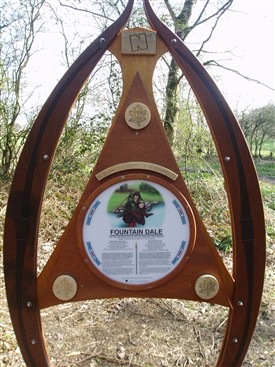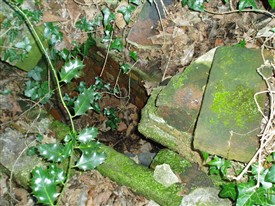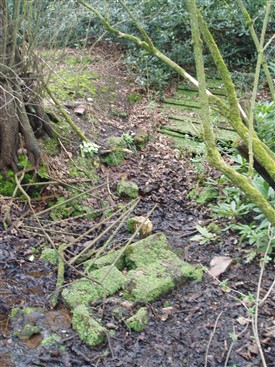Friar Tuck's Well

The sign
RBParish

The well chamber
Holywell@megalithic

The cascade with ruins of well in foreground
Holywell@megalithic
A site we must save!
By R B Parish
Interestingly this is the only other site within the mediaeval borders of Sherwood forest associated with the legend and its pedigree could be considered dubious. Friar Tuck’s Well which is associated with his legendary hermitage. The well was surrounded by ornate railings and low walling and a cascade of water would have run down a series of angled stones after arising at first to fill a small chamber above. Considerable damage was done when an ash tree fell on the site in the 1980s or before. Consequently, the low walling stones have nearly all gone, but when first visited parts of the railings lay buckled and bent emerging from the boggy water. The spring no longer appears to flow down the cascade and there is no water in the chamber above it, but its chalybeate water still emerges from the left hand side of the structure.
A local legend
Local legend suggests that the remains of the moat just before the spring head were where Friar Tuck resided. It is said that when he was ousted from his cell by a Roger de Tallibois, he cursed the springs in this area, making them dry for seven year intervals and indeed in recent heavy rainfall periods the spring has not flowed! Other sources suggest it was Danish raiders who not finding gold in the area cursed the springs.
He also notes that the spring water was still collected by local people for its healing qualities. Was it a pagan site? Does the site have some connection with the Blidworth Boulder, a nearby holed glacial erratic? This is suggested to be able to heal children with rickets and interestingly is also associated with Friar Tuck.
A forlorn folly or hopeless holy well?
It is possible that the site records a local hermit or saint who has become tangled up with Friar Tuck legend. The fact that the well may have been dedicated to a saint is supported by the Rev. R. H. Whitworth, local vicar (1895-1908) who notes to local historian Ernest Smedley that the spring was called St. Lawrence’s Spring. However, I have been unable to find any supporting evidence for this view and it may be wishful thinking by the vicar, (the original church was dedicated to the saint). It could be the Heghwelles noted in documents of 1350 at Ravenshede.Does its name possibly derive from O.E halig or is it another site? Equally the spring could have been purely an estate invention to impress visitors to Fountaindale and the name Friar Tuck attached, especially as the story of Tuck was possibly from Sussex, as two royal writs referring to a Frere Tuk survive from 1429, but of course this date is too late to be associated with Robin Hood who generally is accepted to be ‘active’
This is also at variance to the presence of the character in May plays in the 15th century such as that from 1475’s Robin Hood and the Knightor Robin Hood and the Sheriff, which suggests either a rapid rise to fame or else the Sussex friar was an actor playing the part in this play and using a pseudonym.
Fountain dale or Fountain’s abbey?
The other problem is that it is possible that there is a confusion occuring over the location. It is possible that Fountaindale has been confused by Fountain’s Abbey, and this may be the fault of authors such as Washington Irving who stayed at Fountaindale house and did much to support the legend. The obvious problem with this location is that it was Benedictine and not a Franciscan establishment; they were of course established in Nottingham in the 13th century. It is also worth noting that Fountains Abbey does have a Robin Hood’s Well and a notable stream to cross. The most famous story, of their encounter to refer to Fountaindale however is recorded by Arthur Quiller-Couch, in the Oxford Book of Ballads (1910).
Slowly vanishing from view..
The site really should be better looked after and could make a good local project if the site could be bought from the local landowner to avoid trespass. I have been told that the well was rectangular with steps down in one corner by Frank Earp, noted local historian and member of the Hiddenhistory team. However, I have been unable to find an old photo or illustration to suggest what the structure looked like when in best order (according to local historian Mr. Richards there is not one). Something needs to be done soon as even in the last year the iron railings which once surrounded the site have been removed. It would be sad to see this noted spring, whatever its provenance, fall to vandals and apathy. Sign up, with comments below to show your support and maybe we could do something.
The text is taken and amended from Holy wells and healing springs of Nottinghamshire
Thanks holywell@megalithic for the photos